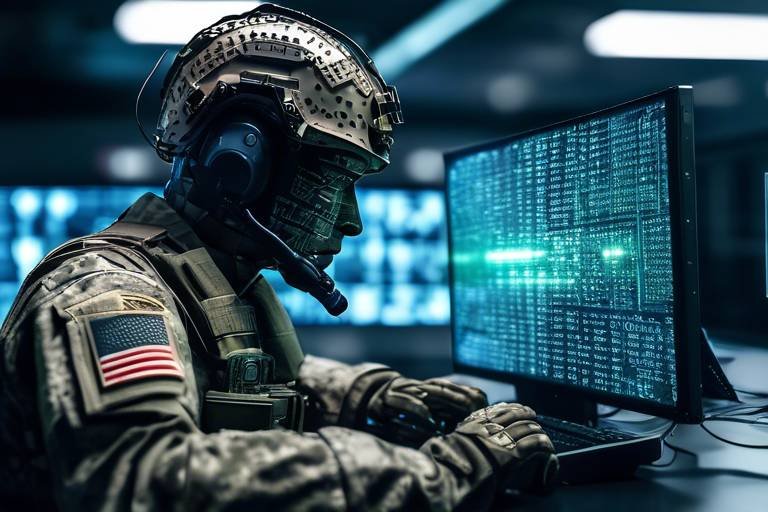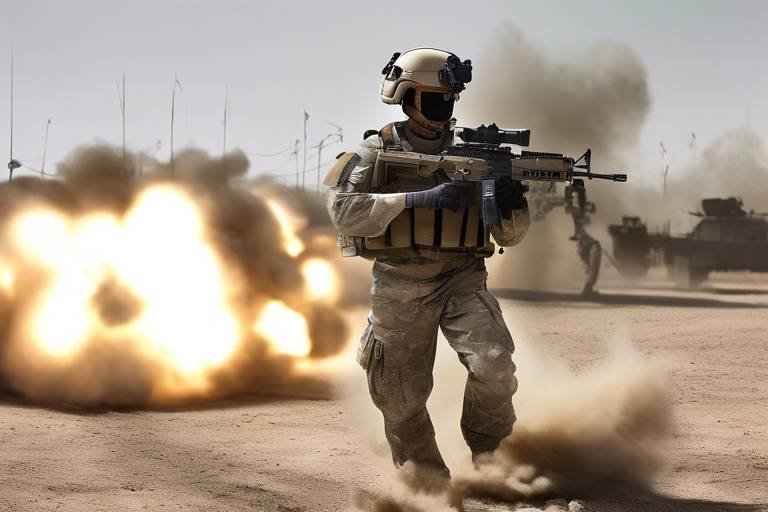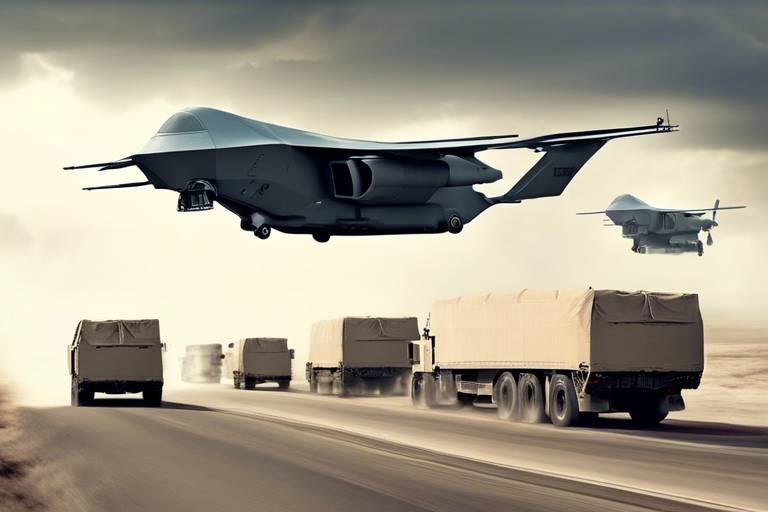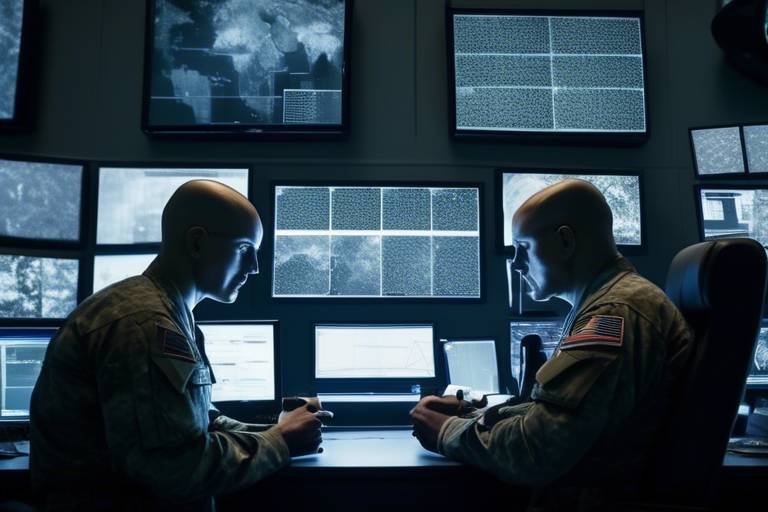The Role of AI in Enhancing Military Cybersecurity
In today's digital age, the battlefield has expanded beyond traditional combat zones into the realm of cyberspace. This transformation has made military cybersecurity more crucial than ever. As nations increasingly rely on digital systems for communication, intelligence, and operations, the threats they face are evolving in complexity and scale. Enter artificial intelligence (AI), a game-changing technology that is revolutionizing how military organizations protect their sensitive information and critical infrastructure.
AI is not just a buzzword; it's a powerful tool that enhances the military's ability to identify, analyze, and respond to cyber threats in real time. Imagine a world where military networks can autonomously recognize potential breaches and neutralize them before they escalate. This is the promise of AI in military cybersecurity. By leveraging advanced algorithms and machine learning, military organizations can transform their cybersecurity strategies from reactive to proactive, allowing them to stay one step ahead of cyber adversaries.
As we delve deeper into the role of AI in military cybersecurity, we'll uncover how it tackles some of the most pressing challenges faced by defense organizations today. From improving threat detection capabilities to automating response systems, AI is reshaping the landscape of cyber defense. But it's not all smooth sailing; the integration of AI comes with its own set of challenges, including ethical considerations and technological limitations that must be addressed. In this article, we will explore these aspects in detail, providing a comprehensive overview of how AI is enhancing military cybersecurity in an increasingly digital battlefield.
Military cybersecurity is about more than just firewalls and antivirus software; it encompasses a wide range of practices aimed at protecting sensitive information and systems from cyber threats. The importance of this field cannot be overstated. With the rise of state-sponsored cyber attacks and the increasing sophistication of cybercriminals, military organizations are under constant pressure to safeguard their digital assets. The unique challenges faced by these organizations include:
- Complex Infrastructure: Military systems are often interconnected and rely on various technologies, making them vulnerable to multiple attack vectors.
- Classified Information: The protection of sensitive data is paramount, and any breach could have national security implications.
- Rapidly Evolving Threat Landscape: Cyber threats are constantly changing, requiring military organizations to adapt their strategies quickly.
Given these challenges, the integration of AI technologies offers a promising solution. By automating threat detection and response, AI can help military organizations enhance their cybersecurity posture and protect their critical assets more effectively.
AI technologies are revolutionizing the way military organizations approach cyber defense. One of the most significant impacts of AI is its ability to enhance threat detection. Traditional cybersecurity methods often struggle to keep up with the speed and sophistication of modern cyber threats. However, AI can analyze vast amounts of data in real time, identifying patterns and anomalies that human analysts might miss. This capability leads to faster response times and a more robust security posture.
Moreover, AI-driven predictive analytics can forecast potential cyber threats by analyzing historical data and identifying trends. This proactive approach allows military organizations to anticipate attacks before they occur, providing a strategic advantage in the digital battlefield.
Predictive analytics is a powerful application of AI that leverages data to forecast potential cyber threats. By analyzing past incidents and identifying patterns, military organizations can gain insights into the tactics used by adversaries. This foresight enables them to implement preventive measures, ultimately reducing the likelihood of successful attacks.
At the heart of predictive analytics are machine learning algorithms. These algorithms learn from historical data, continuously improving their ability to detect anomalies and identify potential threats. For military organizations, this means that the more data they feed into these systems, the better they become at recognizing suspicious behavior, thus enhancing overall threat intelligence.
Real-time threat detection is essential for military cybersecurity. With AI, military networks can identify and mitigate cyber threats instantaneously, significantly reducing the risk of data breaches. This capability is particularly crucial in military operations, where every second counts. By implementing AI-driven systems, military organizations can ensure that they are always prepared to counteract potential threats before they escalate.
Automated response systems powered by AI can drastically reduce reaction times during cyber incidents. These systems can autonomously take action against identified threats, minimizing the impact of attacks. However, the implementation of such systems comes with its own set of challenges, including the need for rigorous testing and validation to ensure that automated decisions align with military protocols and ethical standards.
While the advantages of AI in military cybersecurity are clear, its implementation is not without challenges. Military organizations must navigate a complex landscape of ethical considerations and technological limitations to fully harness the power of AI.
The use of AI in military contexts raises important ethical questions. As autonomous systems become more prevalent, concerns about decision-making processes in cyber warfare emerge. Who is accountable for the actions taken by AI systems? How do we ensure that these systems operate within the bounds of international law? Addressing these ethical dilemmas is essential for the responsible use of AI in military operations.
Despite its potential, AI technology has limitations. Current AI systems may struggle with understanding context or making nuanced decisions, which can lead to false positives or negatives in threat detection. Additionally, the integration of AI into existing military infrastructure can be complex and costly, requiring significant investment in training and resources.
Looking ahead, the integration of AI in military cybersecurity is poised to evolve dramatically. As technology advances, we can expect to see innovations that further enhance defense strategies. From more sophisticated algorithms that can better understand context to improved automated response systems, the future holds exciting possibilities for military cybersecurity.
- What is the role of AI in military cybersecurity? AI enhances threat detection and response, allowing military organizations to protect sensitive information more effectively.
- What are the challenges of implementing AI in military cybersecurity? Challenges include ethical considerations, technological limitations, and the need for rigorous testing of automated systems.
- How does predictive analytics work in military cybersecurity? Predictive analytics uses historical data to forecast potential cyber threats, enabling proactive defense measures.

Understanding Military Cybersecurity
In today's digital landscape, military cybersecurity has become a critical component of national defense strategies. With the increasing reliance on technology for communication, intelligence, and operations, safeguarding sensitive information from cyber threats is more important than ever. Military organizations face unique challenges in this arena, as the stakes are incredibly high. A breach could not only compromise national security but also endanger lives. Imagine a battlefield where enemies can disrupt communications or manipulate data; the consequences could be catastrophic.
Military cybersecurity involves the protection of various digital assets, including networks, systems, and data, from unauthorized access and cyber attacks. This is not just about having firewalls and antivirus software; it's about creating a robust, multi-layered defense strategy. The military must constantly evolve its cybersecurity measures to counteract sophisticated threats that are becoming increasingly prevalent. These threats can come from various sources, including state-sponsored hackers, criminal organizations, and even individual hackers looking to exploit vulnerabilities.
One of the primary challenges in military cybersecurity is the sheer volume of data that needs to be monitored. With thousands of devices connected to military networks, identifying a potential threat amidst all that noise can feel like looking for a needle in a haystack. To address this, military organizations employ advanced technologies, including artificial intelligence and machine learning, to enhance their threat detection capabilities. These technologies can analyze vast amounts of data in real-time, identifying patterns and anomalies that may indicate a cyber attack.
Moreover, the military must also contend with the fact that cyber threats are constantly evolving. Hackers are always looking for new ways to breach defenses, making it essential for military cybersecurity strategies to be dynamic and adaptable. This is where the integration of AI becomes a game-changer. By leveraging predictive analytics, military organizations can anticipate potential attacks before they happen, allowing them to fortify their defenses proactively.
In summary, military cybersecurity is a complex and ever-evolving field that requires a comprehensive approach to protect sensitive information and systems. The unique challenges faced by military organizations necessitate the adoption of advanced technologies and strategies to stay ahead of cyber threats. As we delve deeper into how AI is transforming military cybersecurity, it becomes clear that the future of defense strategies will heavily rely on these innovations.
- What is military cybersecurity? Military cybersecurity refers to the measures taken to protect military information and systems from cyber threats.
- Why is military cybersecurity important? It is crucial for national security, as breaches can compromise sensitive information and endanger lives.
- How does AI enhance military cybersecurity? AI improves threat detection, response times, and overall security posture by analyzing data and identifying patterns.
- What are the main challenges in military cybersecurity? Challenges include the volume of data, evolving cyber threats, and the need for advanced technologies.

The Impact of AI on Cyber Defense
In an era where digital threats are evolving at an unprecedented pace, artificial intelligence (AI) is stepping up as a game-changer in military cybersecurity. Imagine a scenario where military operations are not just reactive but proactive, anticipating cyber threats before they even materialize. This is the promise that AI brings to the table. By harnessing the power of AI, military organizations can enhance their threat detection capabilities, significantly improve response times, and bolster their overall security posture.
AI technologies are revolutionizing the way military forces approach cyber defense. One of the most notable impacts is in the realm of threat detection. Traditional cybersecurity measures often rely on outdated methods that can miss sophisticated attacks. However, AI systems are designed to learn and adapt, making them far more effective at identifying unusual patterns and potential threats. For instance, AI can analyze vast amounts of data in real-time, flagging anomalies that could indicate a cyber intrusion.
Additionally, AI-driven systems can enhance response times. In the military, every second counts, especially when dealing with cyber incidents that could jeopardize national security. AI can automate the initial response to a threat, allowing human operators to focus on more complex decision-making tasks. This automation not only speeds up the reaction process but also minimizes the risk of human error, which is crucial in high-stakes environments.
One of the most fascinating applications of AI in military cybersecurity is through predictive analytics. By leveraging historical data and current threat intelligence, military organizations can forecast potential cyber threats. This proactive approach allows them to strengthen their defenses before an attack occurs. For example, if AI identifies a pattern of behavior that typically precedes a cyber attack, military cybersecurity teams can implement measures to thwart that attack before it even begins.
At the heart of predictive analytics are machine learning algorithms. These algorithms are designed to sift through massive datasets, identifying patterns that would be impossible for human analysts to discern. By continuously learning from new data, these algorithms can improve their accuracy over time, making them invaluable in detecting anomalies and enhancing threat intelligence. This capability not only helps in identifying existing threats but also in predicting future ones, thereby fortifying military defenses.
Real-time threat detection is another critical area where AI shines. With the military's reliance on digital systems, the ability to identify and mitigate cyber threats immediately is paramount. AI systems can monitor network traffic continuously, analyzing data packets for any signs of malicious activity. When a potential threat is detected, the AI can initiate countermeasures, such as isolating affected systems or alerting cybersecurity personnel, all within seconds. This rapid response capability is essential in maintaining the integrity of military operations.
Moreover, the implementation of automated response systems powered by AI can drastically reduce reaction times during cyber incidents. These systems can autonomously execute predefined protocols to counteract threats, freeing up human resources for more strategic tasks. While the benefits are clear, the challenge lies in ensuring these systems are reliable and can operate effectively in complex and dynamic environments.
In conclusion, the impact of AI on military cyber defense is profound and multifaceted. From enhancing threat detection and response times to predicting future attacks, AI is not just a tool; it's a vital ally in the ongoing battle against cyber threats. As military organizations continue to integrate these advanced technologies, we can expect to see a transformation in how they safeguard their digital assets.
- How does AI improve threat detection in military cybersecurity? AI enhances threat detection by analyzing vast amounts of data in real-time, identifying patterns and anomalies that could indicate a cyber threat.
- What role do machine learning algorithms play in military cybersecurity? Machine learning algorithms are crucial for detecting anomalies and improving threat intelligence by learning from historical and current data.
- Can AI automate responses to cyber threats? Yes, AI can automate initial responses to cyber threats, allowing human operators to focus on more complex decision-making tasks.
- What are the challenges of implementing AI in military cybersecurity? Challenges include ethical considerations, technological limitations, and the need for reliable automated systems.

Predictive Analytics in Cybersecurity
In the rapidly evolving landscape of military cybersecurity, predictive analytics has emerged as a powerful tool that transforms the way military organizations anticipate and respond to cyber threats. By leveraging vast amounts of data, predictive analytics enables these organizations to identify potential vulnerabilities before they can be exploited. Imagine having a crystal ball that not only reveals the current state of your defenses but also predicts where the next attack might occur. This capability is not just a dream; it's becoming a reality through the integration of advanced AI technologies.
At its core, predictive analytics utilizes sophisticated algorithms and machine learning techniques to analyze historical data and recognize patterns. This means that military cybersecurity teams can forecast potential attacks based on previous incidents, making it easier to fortify their defenses proactively. For instance, if a particular type of malware has been frequently targeting similar systems, predictive analytics can alert cybersecurity personnel to bolster defenses against that specific threat. This proactive approach is akin to a chess player anticipating their opponent's moves, allowing for strategic adjustments before the game unfolds.
Moreover, the application of predictive analytics extends beyond merely identifying threats. It also enhances the overall decision-making process within military organizations. By presenting actionable insights derived from data analysis, commanders can make informed choices about resource allocation, prioritizing security measures that address the most pressing risks. This level of foresight not only optimizes defense strategies but also ensures that military assets are utilized efficiently.
However, the implementation of predictive analytics is not without its challenges. One of the primary hurdles is the quality and quantity of data available for analysis. Military organizations must ensure that they have access to comprehensive datasets that accurately reflect their operational environment. Additionally, there is a need for continuous updates to algorithms to keep pace with the ever-changing cyber threat landscape. Without constant refinement, predictive models may become obsolete, leaving organizations vulnerable.
To illustrate the effectiveness of predictive analytics in military cybersecurity, consider the following table that outlines key benefits:
| Benefit | Description |
|---|---|
| Proactive Threat Detection | Identifies potential threats before they materialize, allowing for preemptive action. |
| Resource Optimization | Helps allocate resources more effectively by focusing on high-risk areas. |
| Enhanced Decision-Making | Provides actionable insights that support strategic planning and operational decisions. |
| Improved Incident Response | Enables faster reactions to emerging threats, minimizing potential damage. |
In conclusion, predictive analytics is revolutionizing the way military organizations approach cybersecurity. By harnessing the power of data and AI, they can stay one step ahead of cyber adversaries, ensuring the integrity of their operations. As technology continues to advance, the potential for predictive analytics in military contexts will only grow, paving the way for more sophisticated and effective defense strategies.
- What is predictive analytics in cybersecurity?
Predictive analytics in cybersecurity refers to the use of data analysis techniques to forecast potential cyber threats and vulnerabilities, enabling organizations to take proactive measures to protect their systems. - How does AI enhance predictive analytics?
AI enhances predictive analytics by automating data analysis, identifying patterns, and providing insights that help organizations anticipate and mitigate cyber threats more effectively. - What challenges are associated with implementing predictive analytics?
Challenges include data quality and availability, the need for continuous algorithm updates, and the integration of predictive analytics into existing cybersecurity frameworks. - Can predictive analytics prevent cyber attacks?
While predictive analytics cannot guarantee the prevention of cyber attacks, it significantly improves an organization's ability to anticipate and mitigate potential threats before they occur.
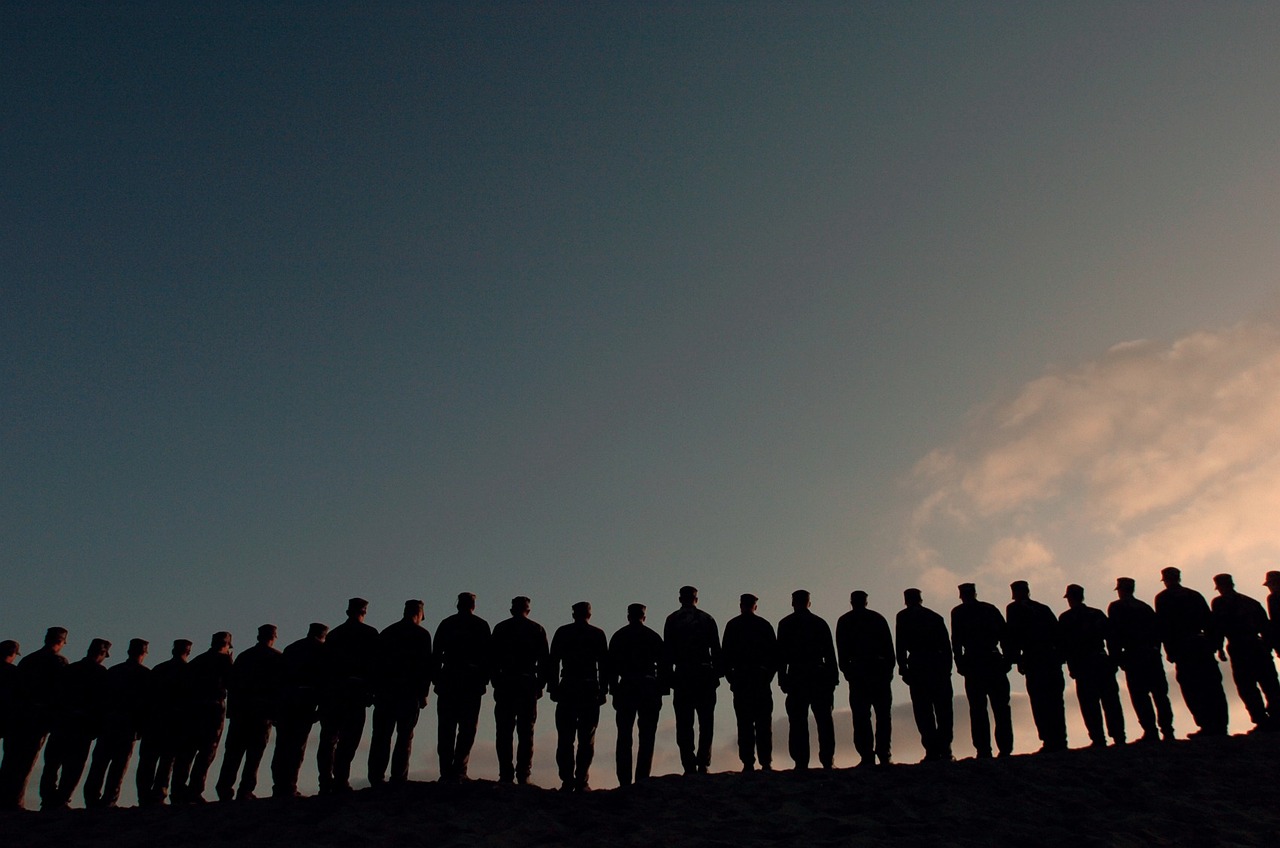
Machine Learning Algorithms
Machine learning algorithms are at the forefront of enhancing military cybersecurity by enabling systems to learn from data and improve over time without being explicitly programmed. Imagine a soldier who becomes more adept with each training session—this is how machine learning works in the digital realm. These algorithms are designed to identify patterns and anomalies within vast datasets, making them invaluable for detecting potential cyber threats before they escalate into full-blown attacks.
In military contexts, where the stakes are incredibly high, the ability to swiftly identify unusual behavior can be the difference between thwarting a cyber assault and suffering catastrophic data breaches. For instance, a machine learning model can analyze network traffic and flag any deviations from normal patterns. If a user typically accesses files during work hours but suddenly attempts to download a large volume of sensitive data at 3 AM, the algorithm can raise an alert. This proactive approach allows military cybersecurity teams to investigate suspicious activities promptly.
Moreover, machine learning algorithms can be categorized into several types, each serving unique purposes in cybersecurity:
- Supervised Learning: This approach involves training algorithms on labeled datasets, where the outcomes are known. It's like teaching a child with flashcards; they learn to recognize patterns based on examples.
- Unsupervised Learning: Unlike supervised learning, this method deals with unlabeled data. The algorithm identifies patterns and structures on its own, making it useful for discovering hidden threats.
- Reinforcement Learning: This technique allows algorithms to learn through trial and error, receiving feedback based on their actions. It's akin to a soldier learning battlefield tactics through simulations.
As military organizations increasingly adopt these machine learning techniques, they can enhance their threat intelligence capabilities. The algorithms can continuously analyze data from various sources, including social media, dark web forums, and internal networks, to provide comprehensive insights into potential threats. The result is a more agile and responsive cybersecurity posture that can adapt to the ever-evolving landscape of cyber warfare.
However, it’s crucial to remember that while machine learning offers tremendous potential, it is not a silver bullet. The effectiveness of these algorithms relies heavily on the quality of the data fed into them. Poor data can lead to inaccurate predictions, which may ultimately compromise security efforts. Therefore, military organizations must invest in robust data management practices to ensure that their machine learning systems operate at peak efficiency.
In summary, machine learning algorithms are transforming military cybersecurity by enabling proactive threat detection and response. As these technologies continue to evolve, they will play an increasingly critical role in safeguarding sensitive information and systems against sophisticated cyber threats.
Q1: What are machine learning algorithms?
Machine learning algorithms are computational methods that enable systems to learn from data, identify patterns, and make predictions or decisions without being explicitly programmed.
Q2: How do machine learning algorithms improve cybersecurity?
They enhance cybersecurity by analyzing vast amounts of data to detect anomalies, predict potential threats, and automate responses to cyber incidents.
Q3: What types of machine learning algorithms are used in military cybersecurity?
Common types include supervised learning, unsupervised learning, and reinforcement learning, each serving different purposes in threat detection and analysis.
Q4: Are machine learning algorithms foolproof?
No, their effectiveness depends on the quality of the input data. Poor data can lead to inaccurate predictions, making robust data management essential.

Real-time Threat Detection
In the fast-paced world of military operations, has become a game-changer. Imagine a battlefield where every second counts, where the difference between a successful defense and a catastrophic breach can hinge on instantaneous responses. This is the reality that military cybersecurity faces today, and AI technologies are stepping up to the plate, transforming how threats are identified and neutralized.
Real-time threat detection systems utilize advanced algorithms and machine learning models to monitor network traffic and identify anomalies that could signify a cyberattack. These systems operate around the clock, tirelessly analyzing vast amounts of data to spot potential threats as they emerge. The beauty of this technology lies in its ability to process information at lightning speed, far surpassing human capabilities. For instance, while a human analyst might take minutes or even hours to sift through logs, an AI system can detect irregularities in mere seconds.
Consider the analogy of a security guard at a busy mall. If the guard relies solely on their eyes to spot trouble, they might miss a suspicious person in a crowd. However, if equipped with advanced surveillance technology that highlights unusual behavior, that guard can react swiftly and effectively. Similarly, AI-enhanced real-time threat detection acts as the eyes and ears of military cybersecurity, ensuring that no potential threat goes unnoticed.
Moreover, the integration of AI in threat detection is not just about speed; it's also about accuracy. Traditional methods often lead to a high rate of false positives, which can overwhelm analysts and divert attention from genuine threats. AI systems, however, are designed to learn and adapt. They continuously improve their detection capabilities by analyzing past incidents and refining their algorithms, thereby enhancing their precision over time.
To illustrate the effectiveness of real-time threat detection, consider the following table that compares traditional methods with AI-driven approaches:
| Feature | Traditional Methods | AI-Driven Methods |
|---|---|---|
| Speed of Detection | Minutes to Hours | Seconds |
| False Positive Rate | High | Low |
| Adaptability | Static | Dynamic |
| Data Processing | Manual | Automated |
This table clearly highlights how AI-driven methods significantly outperform traditional approaches in critical areas. As military organizations continue to embrace these technologies, the landscape of cybersecurity is evolving, making it increasingly difficult for adversaries to exploit vulnerabilities.
However, it’s important to note that while AI can dramatically enhance real-time threat detection, it is not a silver bullet. The effectiveness of these systems is contingent upon the quality of the data they are fed and the algorithms that power them. Continuous updates and maintenance are essential to ensure that these systems remain effective against emerging threats.
In conclusion, real-time threat detection powered by AI represents a revolutionary shift in military cybersecurity. By leveraging advanced technologies, military organizations can not only enhance their defensive capabilities but also ensure that they remain one step ahead of potential cyber adversaries. As we look to the future, the integration of AI in this domain will undoubtedly pave the way for more resilient and responsive defense strategies.
- What is real-time threat detection? Real-time threat detection refers to the ability of systems to identify and respond to cyber threats as they occur, utilizing advanced technologies such as AI.
- How does AI improve threat detection? AI improves threat detection by analyzing vast amounts of data quickly and accurately, learning from past incidents to reduce false positives and enhance response times.
- What challenges does AI face in military cybersecurity? Challenges include ethical considerations, technological limitations, and the need for high-quality data to train AI systems effectively.
- Will AI completely replace human analysts? While AI can significantly enhance threat detection, human analysts will still play a crucial role in interpreting data and making strategic decisions.

Automated Response Systems
In today's rapidly evolving cyber landscape, are becoming a game-changer for military cybersecurity. Imagine a team of highly skilled soldiers, but instead of being on the battlefield, they are stationed in a digital realm, constantly on guard against unseen threats. These systems leverage the power of artificial intelligence to react swiftly and effectively to cyber incidents, significantly reducing the time it takes to address potential breaches. This capability is crucial, as every second counts when it comes to defending sensitive military information.
One of the most notable advantages of automated response systems is their ability to operate without human intervention. This means that when a cyber threat is detected, the system can initiate a series of pre-defined actions to mitigate the risk. For instance, if an intrusion is identified, the system can automatically isolate affected networks, alerting human operators only when necessary. This not only expedites the response but also allows military personnel to focus on strategic decision-making rather than getting bogged down in routine tasks.
However, implementing these systems is not without its challenges. The technology must be meticulously designed to ensure that it can accurately differentiate between genuine threats and false alarms. Imagine a fire alarm that goes off every time someone cooks in the kitchen; it would quickly lose its effectiveness. Similarly, if automated systems trigger responses too frequently for non-threatening activities, they risk causing alarm fatigue among military personnel, potentially leading to critical threats being overlooked.
Moreover, the integration of automated response systems into existing military frameworks requires careful planning and consideration. As these systems become more sophisticated, they must also be able to adapt to the ever-changing tactics of cyber adversaries. This necessitates a continuous cycle of updates and training to ensure that the systems remain effective against new and evolving threats.
To illustrate the potential impact of automated response systems, consider the following table that outlines key benefits and challenges:
| Benefits | Challenges |
|---|---|
| Faster response times to cyber incidents | Risk of false positives leading to alarm fatigue |
| Reduced workload for human operators | Need for continuous updates and training |
| Ability to operate 24/7 without breaks | Integration with existing military frameworks |
| Enhanced threat mitigation strategies | Ethical considerations regarding autonomous actions |
In conclusion, while automated response systems offer significant advantages in enhancing military cybersecurity, their successful implementation hinges on addressing the challenges associated with their deployment. As technology continues to advance, the military must remain vigilant, ensuring that these systems are not only effective but also aligned with ethical standards and operational protocols.
- What are automated response systems in military cybersecurity?
Automated response systems are AI-driven technologies that enable military organizations to react swiftly to cyber threats without human intervention. - How do these systems improve response times?
They can identify threats and initiate pre-defined actions almost instantly, significantly reducing the time it takes to mitigate risks. - What are the main challenges of implementing automated response systems?
Challenges include the risk of false positives, the need for continuous updates, and the integration with existing military frameworks. - Are there ethical concerns associated with automated systems?
Yes, the use of autonomous systems raises questions about decision-making in cyber warfare and the potential for unintended consequences.

Challenges in AI Implementation
As the military sector increasingly turns to artificial intelligence (AI) to bolster cybersecurity, it faces a myriad of challenges that can hinder effective implementation. One of the most pressing issues is the **ethical implications** surrounding the use of AI in military operations. The deployment of autonomous systems raises questions about accountability and decision-making in high-stakes environments. For instance, if an AI system mistakenly identifies a threat and initiates a counteraction, who is responsible for that decision? This dilemma not only complicates legal frameworks but also instills a sense of unease among military personnel and the public alike.
Furthermore, the **technological limitations** of current AI systems pose significant hurdles. While AI has made great strides in recent years, it is not infallible. Many military organizations grapple with the reality that AI systems can sometimes produce false positives or fail to recognize sophisticated cyber threats. These shortcomings can lead to a false sense of security, where military units may become complacent, believing that AI will handle all cybersecurity threats. The reality, however, is that human oversight remains crucial in the decision-making process, particularly when it comes to interpreting AI-generated data.
In addition to ethical and technological challenges, the **integration of AI into existing military frameworks** can be a daunting task. Many military organizations operate on legacy systems that are not designed to accommodate modern AI technologies. This can result in a fragmented cybersecurity approach, where new AI solutions are bolted onto outdated systems, leading to inefficiencies and potential vulnerabilities. The challenge lies in not just implementing AI, but ensuring that it works seamlessly with existing protocols and infrastructure.
Moreover, there is the issue of **data privacy and security**. Military organizations handle vast amounts of sensitive information, and integrating AI systems requires careful consideration of how this data is used and stored. Ensuring that AI systems do not inadvertently expose sensitive information is paramount, as any breach could have dire consequences not only for military operations but also for national security. Thus, a robust framework for data governance must be established alongside the implementation of AI technologies.
To summarize, the challenges in implementing AI for military cybersecurity are multifaceted and complex. They encompass ethical dilemmas, technological limitations, integration issues, and data security concerns. Addressing these challenges requires a concerted effort from military leaders, technologists, and policymakers alike. As we move forward, it is essential to foster a collaborative environment where these issues can be openly discussed and solutions can be developed, ensuring that the benefits of AI are fully realized while minimizing the risks associated with its deployment.
- What are the primary ethical concerns regarding AI in military cybersecurity?
The primary ethical concerns include accountability for decisions made by autonomous systems, the potential for misuse of AI technologies, and the implications for civilian safety during military operations. - How do technological limitations affect AI's effectiveness in military cybersecurity?
Technological limitations may lead to false positives or the inability to recognize advanced cyber threats, which can compromise security and create a false sense of safety. - What challenges arise from integrating AI into existing military systems?
Integration challenges include compatibility with legacy systems, potential inefficiencies, and the need for significant training and adaptation within military organizations. - How can data privacy be ensured when using AI in military contexts?
Establishing a robust data governance framework is essential for ensuring that sensitive information is protected, and that AI systems do not expose this data to unauthorized access.

Ethical Considerations
As military organizations increasingly turn to artificial intelligence (AI) for cybersecurity, become paramount. The advent of autonomous systems raises pressing questions about accountability, decision-making, and the potential for unintended consequences. Imagine a scenario where an AI system autonomously decides to counteract a perceived cyber threat—who is responsible if that decision leads to collateral damage? This is a complex dilemma that military leaders must navigate.
One significant concern is the autonomy of AI systems in warfare. When machines are empowered to make decisions without human intervention, the risk of errors increases. For instance, an AI could misinterpret data and launch a counterattack against a benign entity, believing it to be a threat. This not only raises ethical questions about the nature of warfare but also challenges the fundamental principles of human oversight and accountability.
Moreover, the deployment of AI in military contexts can exacerbate the moral distance between decision-makers and the consequences of their choices. If a military commander relies on an AI system to identify and neutralize threats, they may feel less personally responsible for the outcomes. This detachment can lead to a desensitization to the implications of military action, which is particularly troubling in the realm of cyber warfare, where the lines between combatants and non-combatants can blur.
Another ethical aspect to consider is the potential for bias in AI algorithms. If the data fed into these systems is biased or incomplete, the AI may produce skewed results, leading to unfair or harmful actions against certain groups. For example, if an AI system is trained on historical data that reflects biased decision-making, it may perpetuate those biases in future operations. This raises questions about fairness and justice in military actions.
To address these ethical dilemmas, military organizations must establish robust frameworks for the responsible use of AI in cybersecurity. This includes:
- Human Oversight: Ensuring that human operators remain in control of critical decisions, especially those that could result in significant harm.
- Transparency: Developing AI systems that are explainable, enabling decision-makers to understand the rationale behind AI recommendations.
- Bias Mitigation: Implementing strategies to identify and correct biases in AI algorithms to ensure fair treatment of all entities.
As we move forward, it is essential for military leaders and policymakers to engage in ongoing discussions about the ethical implications of AI in cybersecurity. By fostering a culture of responsibility and accountability, the military can harness the power of AI while minimizing its potential risks. The balance between technological advancement and ethical integrity will be crucial in shaping the future of military operations in the digital age.
- What are the main ethical concerns regarding AI in military cybersecurity? Ethical concerns include accountability for decisions made by autonomous systems, potential bias in AI algorithms, and the moral implications of distancing decision-makers from the consequences of their actions.
- How can military organizations ensure ethical AI use? By establishing frameworks that emphasize human oversight, transparency in AI decision-making, and bias mitigation strategies, military organizations can promote responsible AI use.
- What role does human oversight play in AI decision-making? Human oversight is crucial to maintain accountability and ensure that AI systems do not operate entirely autonomously, especially in high-stakes scenarios.

Technological Limitations
While the integration of artificial intelligence (AI) into military cybersecurity offers immense potential, it is essential to recognize the that accompany this advancement. One of the most significant challenges is the complexity of AI systems. These systems require vast amounts of data to learn and adapt, and military organizations often operate under strict data security regulations that can hinder the availability of such data. This limitation can lead to insufficient training of AI models, resulting in less effective threat detection and response capabilities.
Moreover, the dynamic nature of cyber threats poses another hurdle. Cybercriminals are constantly evolving their tactics, techniques, and procedures (TTPs) to bypass security measures. AI systems, while capable of learning from existing data, may struggle to adapt quickly enough to new and unforeseen threats. This lag in adaptation can leave military systems vulnerable to attacks that exploit these technological gaps.
Another critical limitation is the dependency on human oversight. Despite the automation capabilities of AI, human intervention remains crucial in several aspects of military cybersecurity. For instance, decision-making in high-stakes scenarios often requires human judgment, which AI cannot replicate. This dependency can slow down response times, as military personnel must analyze AI-generated data and make informed decisions based on their expertise and experience.
Additionally, the integration of AI with existing military infrastructure can be a daunting task. Many military organizations rely on legacy systems that may not be compatible with advanced AI technologies. This incompatibility can lead to significant challenges in implementation, requiring extensive resources for upgrades and training. The transition to AI-enhanced systems must be carefully managed to avoid disruptions in critical operations.
Lastly, the issue of cybersecurity for AI systems themselves cannot be overlooked. As military organizations increasingly rely on AI for their cybersecurity measures, they also become targets for adversaries aiming to exploit vulnerabilities within these AI systems. Ensuring the security of AI technologies is paramount, as any breach could have devastating consequences, potentially compromising sensitive military operations.
In summary, while AI presents exciting opportunities for enhancing military cybersecurity, its technological limitations must be addressed. Understanding these challenges is crucial for military organizations as they navigate the complex landscape of cyber defense and strive to implement effective AI solutions.
- What are the main technological limitations of AI in military cybersecurity? The main limitations include the complexity of AI systems, the dynamic nature of cyber threats, dependency on human oversight, integration challenges with legacy systems, and the need for cybersecurity of AI technologies themselves.
- How can military organizations overcome these limitations? Military organizations can invest in training, enhance data-sharing protocols, and develop hybrid systems that combine human expertise with AI capabilities to improve decision-making and response times.
- Is AI capable of fully automating military cybersecurity? While AI can automate many processes, complete automation is not feasible due to the need for human judgment in critical decision-making scenarios.
- What role does data play in the effectiveness of AI for cybersecurity? Data is crucial for training AI models. The quality and quantity of data directly impact the effectiveness of AI in identifying and responding to cyber threats.

The Future of AI in Military Cybersecurity
As we look to the horizon of military cybersecurity, the integration of artificial intelligence (AI) is not just a trend; it’s a pivotal evolution that promises to redefine how armed forces protect their digital assets. Imagine a battlefield where cyber threats are not only detected in real-time but also anticipated and neutralized before they can cause harm. This is the future that AI is paving the way for, and it’s both exciting and daunting.
One of the most significant advancements we can expect is the development of adaptive AI systems that learn and evolve in response to emerging threats. These systems will utilize advanced algorithms to analyze vast amounts of data, identifying patterns and anomalies with unprecedented speed and accuracy. This capability will not only enhance threat detection but also improve decision-making processes, allowing military personnel to respond more effectively to cyber incidents.
Furthermore, the future of AI in military cybersecurity will likely see an increase in collaborative defense strategies. Imagine a network of military units sharing real-time intelligence about cyber threats, all powered by AI. This collective approach will enhance situational awareness and create a more robust defense posture. The synergy between different branches of the military, supported by AI, will ensure that no unit is left vulnerable, creating a comprehensive shield against cyber adversaries.
However, with great power comes great responsibility. As military organizations embrace AI, they will also need to address significant ethical considerations. The deployment of autonomous systems in cyber warfare raises questions about accountability and decision-making. For instance, if an AI system makes a mistake that results in collateral damage, who is held responsible? These are complex issues that will require careful deliberation and robust governance frameworks to navigate.
Moreover, the technological landscape is always evolving, and military organizations must stay ahead of the curve. Continuous investment in research and development will be crucial. This includes not only enhancing existing AI technologies but also exploring new ones, such as quantum computing, which has the potential to revolutionize data processing and encryption methods.
In summary, the future of AI in military cybersecurity is filled with potential and challenges. As we forge ahead, it is essential for military leaders to embrace innovation while remaining vigilant about the ethical implications and technological limitations. The road ahead may be fraught with obstacles, but the rewards of a secure, AI-enhanced military landscape are well worth the effort.
- What role does AI play in military cybersecurity?
AI enhances threat detection, response times, and overall security strategies, making it a critical component for modern military operations. - What are the ethical concerns associated with AI in the military?
Ethical concerns include accountability for autonomous decision-making and the potential for misuse in cyber warfare. - How can military organizations ensure the effective implementation of AI?
Continuous research, investment in technology, and robust governance frameworks are essential for effective AI implementation in military cybersecurity.
Frequently Asked Questions
- What is military cybersecurity?
Military cybersecurity refers to the practices and technologies used to protect sensitive military information and systems from cyber threats. It involves safeguarding data, networks, and infrastructure to ensure operational security and maintain the integrity of defense operations.
- How does AI enhance military cybersecurity?
AI enhances military cybersecurity by improving threat detection, response times, and overall security posture. Through predictive analytics and machine learning algorithms, AI can analyze vast amounts of data to identify patterns and forecast potential cyber threats, allowing military organizations to act proactively.
- What role do machine learning algorithms play in cybersecurity?
Machine learning algorithms are crucial in identifying anomalies and improving threat intelligence. They analyze historical data to learn what normal behavior looks like, enabling them to detect deviations that may indicate a cyber attack, thus enhancing the effectiveness of cybersecurity measures.
- What is real-time threat detection?
Real-time threat detection refers to the immediate identification and mitigation of cyber threats as they occur. AI-powered systems can monitor networks continuously, providing instant alerts and responses to potential breaches, which is essential for maintaining military cybersecurity.
- What are automated response systems?
Automated response systems are AI-driven mechanisms that can react to cyber incidents without human intervention. These systems can significantly reduce reaction times during attacks, allowing for quicker containment and remediation of threats, although they also come with challenges regarding reliability and decision-making.
- What challenges does AI face in military cybersecurity?
AI implementation in military cybersecurity faces several challenges, including ethical considerations regarding autonomous decision-making in warfare and technological limitations such as data quality and integration issues. These challenges must be addressed to fully leverage AI's potential in defense strategies.
- What ethical considerations are involved in using AI for military purposes?
The use of AI in military contexts raises ethical questions, particularly concerning the implications of autonomous systems making decisions related to cyber warfare. Issues such as accountability, transparency, and the potential for unintended consequences must be carefully considered.
- What does the future hold for AI in military cybersecurity?
The future of AI in military cybersecurity looks promising, with ongoing advancements expected to reshape defense strategies. Innovations in AI technologies will likely lead to more robust and adaptive security measures, enhancing the military's ability to combat evolving cyber threats.

